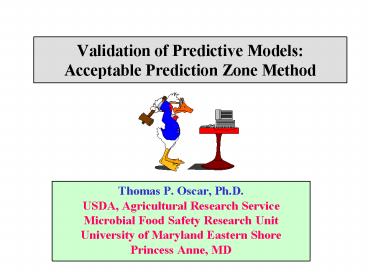Validation of Predictive Models: Acceptable Prediction Zone Method - PowerPoint PPT Presentation
Title:
Validation of Predictive Models: Acceptable Prediction Zone Method
Description:
Validation of Predictive Models: Acceptable Prediction Zone Method Thomas P. Oscar, Ph.D. USDA, Agricultural Research Service Microbial Food Safety Research Unit – PowerPoint PPT presentation
Number of Views:78
Avg rating:3.0/5.0
Title: Validation of Predictive Models: Acceptable Prediction Zone Method
1
Validation of Predictive Models Acceptable
Prediction Zone Method
- Thomas P. Oscar, Ph.D.
- USDA, Agricultural Research Service
- Microbial Food Safety Research Unit
- University of Maryland Eastern Shore
- Princess Anne, MD
2
Background Information
3
Terminology
- Performance evaluation
- Process of comparing observed and predicted
values. - Validation
- A potential outcome of performance evaluation.
- Requires establishment of criteria.
4
Criteria
- Test Data
- Interpolation
- Extrapolation
- Performance
- Bias
- Accuracy
- Systematic Bias
5
Predictive Modeling
Secondary Models
Tertiary Model
No Model
Observed No
Predicted No
Observed N(t)
l Model
Observed l
Predicted l
Primary Model
Primary Model
mmax Model
Observed mmax
Predicted mmax
Predicted N(t)
Predicted N(t)
Nmax Model
Observed Nmax
Predicted Nmax
6
Performance Evaluation
Stage 1
Goodness-of-fit Primary/Secondary Models
Verification Tertiary Models
Stage 2
Interpolation All Models
Stage 3
Extrapolation All Models
7
Test Data CriteriaInterpolation
- Independent data.
- Within the response surface.
- Uniform coverage.
- Collected with same methods.
Incomplete and biased evaluation Model data (10
to 40C) versus Test data (25 to 40C)
8
Test Data CriteriaExtrapolation
- Independent data.
- Outside the response surface.
- Only one variable differs.
- Collected with same methods.
Confounded comparison Strain A in broth
versus Strain B in food
9
Acceptable Prediction Zone MethodDescription
10
Relative Error (RE)
RE for ? (predicted - observed)/predicted
RE for N(t), No, ?max and Nmax (observed -
predicted)/predicted RE lt 0 are fail-safe RE
gt 0 are fail-dangerous
11
Performance Factor RE REIN/RETOTAL
12
Performance Criteria
- Acceptable Predictions
- -0.30 lt RE lt 0.15 for mmax
- -0.60 lt RE lt 0.30 for l
- -0.80 lt RE lt 0.40 for N(t), No, Nmax
- Acceptable Performance
- RE gt 70
13
Acceptable Prediction Zone MethodDemonstration
14
Model Development Design
- Salmonella Typhimurium
- No 4.8 log CFU/g
- Sterile cooked chicken
- 10, 12, 14, 16, 20, 24, 28, 32, 36, 38, 40C
- Viable counts
- BHI agar
- 12 per growth curve
15
Performance Evaluation DesignSecondary Models
(Interpolation)
- Salmonella Typhimurium
- No 4.8 log CFU/g
- Sterile cooked chicken
- 11, 13, 15, 18, 22, 26, 30, 34, 37, 39C
- Viable counts
- BHI agar
- 12 per growth curve
16
Primary ModelLogistic with Delay
N No if t ? ? N Nmax/(1(Nmax/No)-
1exp-?max (t-?)) if t gt ?
17
Primary Model PerformanceGoodness-of-fit
18
Secondary Model for No
No mean No
19
No Model Performance
20
Secondary Model for lHyperbola with Shape Factor
? 41.47/(T - 7.325)1.44
21
l Model Performance
22
Secondary Model for mmaxModified Square Root
?max 0.01885 if T ? 11.43 ?max
0.01885 0.004325(T 11.43)1.306 if T gt
11.43
23
mmax Model Performance
24
Secondary Model for NmaxAsymptote Model
Nmax exp(2.348((T 9.64)(T 40.74))/((T
9.606)(T 40.76)))
25
Nmax Model Performance
26
Predictive Modeling
Secondary Models
Tertiary Model
No Model
Observed No
Predicted No
Observed N(t)
l Model
Observed l
Predicted l
Primary Model
Primary Model
mmax Model
Observed mmax
Predicted mmax
Predicted N(t)
Predicted N(t)
Nmax Model
Observed Nmax
Predicted Nmax
27
Tertiary Model PerformanceVerification
RE 90.7
28
Comparison of Models
Model REIN REOUT RETOTAL
Primary 121 8 129
Tertiary 117 12 129
Total 238 20 258
Fishers exact test P 0.48, not significant.
29
Performance Evaluation DesignTertiary Model
(Interpolation)
- Salmonella Typhimurium
- No 4.8 log CFU/g
- Sterile cooked chicken
- 11, 13, 15, 18, 22, 26, 30, 34, 37, 39C
- Viable counts
- BHI agar
- 4 per growth curve
30
Tertiary Model Performance Interpolation
31
Tertiary Model Performance Interpolation
RE 97.5
32
Should the validated tertiary model be used to
predict chicken safety?
- Evaluation for extrapolation to
- other initial densities (No) ?
- other strains
- other chicken products
33
Performance Evaluation DesignTertiary Model
(Extrapolation)
- Salmonella Typhimurium
- No 0.8 log CFU/g
- Sterile cooked chicken
- 10, 12, 14, 16, 20, 24, 28, 32, 36, 40C
- Viable counts
- BHI agar
- 4 per growth curve
34
Tertiary Model Extrapolation to low No
35
Tertiary Model PerformanceExtrapolation to low No
RE 2.5
36
Conclusions
- Criteria are important for evaluating performance
of models. - Consensus on validation would improve the quality
and use of predictive models in the food industry.































